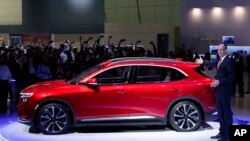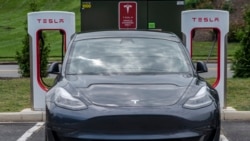Persistently high prices for gasoline are frustrating many Americans and causing a political headache for the administration of President Joe Biden, but they also might be accelerating the process of transitioning the country to more widespread use of vehicles that run on renewable energy — particularly electricity.
Experts say that sales of electric vehicles, or EVs, tend to rise when fuel prices do, though they cautioned it’s difficult to draw a straight line from prices at the pump to car purchases.
“People buy electric cars for lots of reasons, so they're not completely dependent on gas prices, but that's certainly reinforcing it,” said Genevieve Cullen, president of the Electric Drive Transportation Association, a trade group representing manufacturers of electric vehicles.
An estimated 468,000 new EVs were sold in the U.S. from the beginning of the year through September, according to data collected by Atlas Public Policy, a group that tracks the market for EVs. That represents a 45% increase over the 323,000 EVs sold during the entirety of 2020.
Looking solely at the month of September 2021, U.S. consumers bought 57,000 new EVs. That was 63% more than the 35,000 sold in September of 2020, and a 90% increase over the 30,000 sold in September 2019.
Gas prices make EVs attractive
According to the Bureau of Labor Statistics, the cost of one kilowatt hour of electricity in the United States rose from 13.5 cents in October 2020 to 14.2 cents in October 2021, an increase of 5.2%. By contrast, the BLS found the average cost of a gallon of gas rose from $2.23 in October 2020 to $3.48 in October 2021, a 56.1% increase.
“High gas prices are tough on Americans driving gasoline vehicles,” said Luke Tonachel, director of clean vehicles and fuels for the Natural Resources Defense Council. “The volatility in the global price of the oil used to make gasoline is a constant worry.
In the U.S., though, the structure of the electricity market keeps prices from increasing sharply.
“Electricity prices are regulated, and therefore quite stable,” said Tonachel. “An EV driver can expect to pay a quarter or less as much per mile as [someone] driving a gasoline vehicle.”
US EV sales expected to rise further
While electric vehicle sales are rising rapidly, the numbers begin from a low baseline. As recently as five years ago, EV sales accounted for less than 1% of new vehicles sold in the U.S. That figure has surged to what is expected to be about 4% this year, and the real increase is on the horizon.
LMC Automotive, which tracks vehicle sales and estimates the future of the market, projects that by 2030, EVs, including purely electric cars and plug-in hybrid cars that can run on both electricity and gasoline, will make up 34.2% of new vehicle sales in the United States.
That transition will continue, as the federal government increasingly crafts policies meant to bring the country in line with President Biden’s promise, made at the recent United Nations Climate Conference, to cut U.S. greenhouse gas emissions to about half of their 2005 levels by 2030.
The Environmental Protection Agency announced this summer it would structure emissions guidelines for cars powered by internal combustion engines in order to “speed the transition of the light-duty vehicle fleet toward a zero emissions future.”
“We're going to see the car market accelerate the shift to EVs when the U.S. EPA sets emission standards that zero out pollution from vehicles,” said Tonachel. “That's ultimately what we need to address the climate crisis, and it will result in cheaper mobility, too.”
Another factor is the continued rollout of a network of charging stations across the country. The Energy Department currently lists more than 52,000 stations in the country, with upwards of 100,000 outlets. The infrastructure bill that President Biden recently signed into law contains $7.5 billion aimed at increasing that number by a factor of 10 within the next decade.
Broader future for renewables
There also is reason to believe that increased electrification of the transportation system will drive the adoption of renewables in other aspects of day-to-day life, as well. That’s because, as car battery technology continues to improve, it will make it easier and cheaper to store energy generated by wind and solar power sources.
“Electrification of transportation is the key to growing renewables in the power sector,” said Cullen, of the Electric Drive Transportation Association. “Because batteries are one of the few effective and portable ways to store electricity. They'll enable utilities and other power generators to manage demand so that you can save up excess wind or solar.”
She added, “Battery storage is the path there. Electric transportation, this mobile electrical load, has the ability to be a grid asset.”








